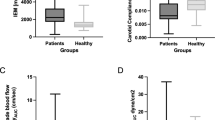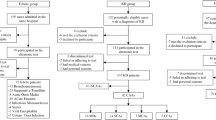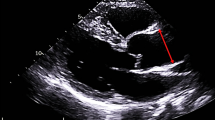Abstract
Endothelial injury and increased vascular reactivity are involved in the pathogenesis of pre-eclampsia (pregnancy-induced hypertension). To investigate whether flow-mediated dilation (endothelium-dependent dilation) and the reactive hyperemic response can predict pre-eclampsia, we prospectively measured flow-mediated dilation and the Doppler flow velocity pattern (V, cm/s) in the brachial artery using high-resolution ultrasound in 43 pregnant women (32±5 years old) in the second half of their pregnancy, and compared the findings with traditional risk factors. Regarding the Doppler flow velocity pattern, the pulsatility index (PI)=(systolic V−diastolic V)/mean V and resistance index (RI)=(systolic V−diastolic V)/systolic V were calculated. For the flow-mediated dilation, the per cent diameter changes were determined based on those from baseline to hyperemic conditions. Nine women suffered from pre-eclampsia and 34 women remained normotensive. Only flow-mediated dilation was found to be significantly lower in the subsequently developed pre-eclampsia patients (1.6±1.0% in subsequently developed pre-eclampsia patients vs 11.0±4.5% in normotensive patients, P<0.05). Neither the other traditional factors nor the Doppler flow velocity pattern were significantly different between the subsequently developed pre-eclampsia and normotensive patients. If a normal cutoff value of 3.0% obtained from age-matched 14 nonpregnant women (32±7 years old) in our laboratory was used, the positive predictive value of flow-mediated dilation (<3.0%) for subsequent pre-eclampsia is 90% and the negative predictive value is 100%. In conclusion, flow-mediated dilation in brachial artery can be a simple and noninvasive modality to predict pre-eclampsia.
This is a preview of subscription content, access via your institution
Access options
Subscribe to this journal
Receive 12 digital issues and online access to articles
$119.00 per year
only $9.92 per issue
Buy this article
- Purchase on Springer Link
- Instant access to full article PDF
Prices may be subject to local taxes which are calculated during checkout



Similar content being viewed by others
References
Roberts JM . Objective evidence of endothelial dysfunction in preeclampsia. Am J Kidney Dis 1999; 33: 992–997.
McCarthy AL, Woolfson RG, Raju SK, Poston L . Abnormal endothelial cell function of resistance arteries from women with preeclampsia. Am J Obstet Gynecol 1993; 168: 1323–1330.
Vielle JC, Gorsuch L, Weeks W, Zaccaro D . Hyperemic response of the brachial artery during the second half of pregnancy. J Soc Gynecol Invest 1998; 5: 38–43.
Anderson TJ et al. Close relation of endothelial function in the human coronary and peripheral circulation. J Am Coll Cardiol 1995; 26: 1235–1241.
Celermajer DS et al. Non-invasive detection of endothelial dysfunction in children and adults at risk of atherosclerosis. Lancet 1992; 340: 1111–1115.
Uehata A et al. Non-invasive assessment of endothelium-dependent flow-mediated dilation of brachial arteries. Vasc Med 1997; 2: 87–92.
Totsune K et al. Detection of immunoreactive endothelin in plasma of hemodialysis patients. FEBS Lett 1989; 249: 239–242.
Pettersson A, Uggla L, Beckman V . Determination of dimethylated arginines in human plasma by high-performance liquid chromatography. J Chromatogr B Biomed Sci Appl 1997; 692: 257–262.
Report of the National High Blood Pressure Education Program Working Group on High Blood Pressure in Pregnancy. Am J Obstet Gynecol 2000; 183: s1–s22.
Bland JM, Altman DG . Statistical methods for assessing agreement between two methods of clinical measurement. Lancet 1986; 1(8476): 307–310.
Chaitman BR . Exercise stress testing. In: Braunwald E (ed). Heart Disease, 5th edn. W.B. Saunders Company: Philadelphia, 1997; pp 161–163.
Roberts JM . Pathogenesis and genetics of pre-eclampsia. Lancet 2001; 357: 53–56.
Hashimoto M et al. Modulation of endothelium-dependent flow-mediated dilatation of the brachial artery by sex and menstrual cycle. Circulation 1995; 92: 3431–3435.
Seligman SP, Abramson SB, Young BK, Buyon JP . The role of nitric oxide in the pathogenesis of pre-eclampsia. Am J Obstet Gynecol 1994; 172: 944–948.
Di Iorio R et al. Lack of evidence for decreased production. Eur J Obstet Gynecol Rep Biol 1998; 76: 65–70.
Silver RK et al. Evaluation of nitric oxide as a mediator of severe preeclampsia. Am J Obstet Gynecol 1996; 175: 1013–1017.
Cockell AP, Poston L . Flow mediated vasodilation is enhanced in normal pregnancy but reduced in preeclampsia. Hypertension 1997; 30: 247–251.
Pascoal IF, Lindheimer MD, Nalbantian-Brandt C, Umans JG . Preeclampsia selectively impairs endothelium-dependent relaxation and leads to oscillatory activity in small omental arteries. J Clin Invest 1998; 101: 464–470.
Yoshida A, Nakao S, Kobayashi M, Kobayashi H . Noninvasive assessment of flow-mediated vasodilation with 30-MHz transducer in pregnant women. Hypertension 1998; 31: 1200.
Wellings RP, Brockelsby JC, Baker PN . Activation of endothelial cells by plasma from women with preeclampsia: differential effects on four endothelial cell types. J Sco Gynecol Invest 1998; 5: 31–37.
Nishikawa S, Miyamoto A, Ohshika H, Kudo R . The relationship between serum nitrate and endothelin-1 concentrations in preeclampsia. Life Science 2000; 67: 1447–1454.
Hubel CA et al. Low-density lipoprotein particle size decreases during normal pregnancy in association with triglyceride increases. J Soc Gynecol Invest 1998; 5: 244–250.
Davidge ST . Oxidative stress and altered endothelial cell function in preeclampsia. Semin Reproduct Endocrinol 1998; 16: 65–73.
Holden DP, Fickling SA, Whitley GS, Nussey SS . Plasma concentration of asymmetric dimethylarginine, a natural inhibitor of nitric oxide synthase, in normal pregnancy and preeclampsia. Am J Obstet Gynecol 1998; 178: 551–556.
Chambers JC et al. Association of maternal endothelial dysfunction with preeclampsia. JAMA 2001; 285: 1607–1612.
Dorup I, Skajaa K, Sorensen KE . Normal pregnancy is associated with enhanced endothelium-dependent flow-mediated vasodilatation. Am J Physiol 1999; 276: H821–H825.
Savvidou MD, Donald AE, Nicolaides KH . Assessment of endothelial function in normal twin pregnancy. Ultrasound Obstet Gynecol 2001; 17: 220–223.
Tomoda S, Kitanaka T, Ogita S, Hidaka A . Prediction of pregnancy-induced hypertension by isometric exercise. Asia Oceania J Obstet Gynecol 1994; 3: 249–255.
National High Blood Pressure Education Program Working Group. Report on high blood pressure during pregnancy. Am J Obstet Gynecol 1990; 163: 1691–1712.
Imperiale TF, Petulis AS . A meta-analysis of low-dose aspirin for the prevention of pregnancy-induced hypertensive disease. JAMA 1991; 266: 260–264.
Author information
Authors and Affiliations
Corresponding author
Rights and permissions
About this article
Cite this article
Takase, B., Goto, T., Hamabe, A. et al. Flow-mediated dilation in brachial artery in the second half of pregnancy and prediction of pre-eclampsia. J Hum Hypertens 17, 697–704 (2003). https://doi.org/10.1038/sj.jhh.1001599
Received:
Revised:
Accepted:
Published:
Issue Date:
DOI: https://doi.org/10.1038/sj.jhh.1001599
Keywords
This article is cited by
-
Placental Growth Factor in First Trimester of Pregnancy for Prediction of Maternal and Perinatal Adverse Outcomes
The Journal of Obstetrics and Gynecology of India (2022)
-
Flow-Mediated Dilation: Can New Approaches Provide Greater Mechanistic Insight into Vascular Dysfunction in Preeclampsia and Other Diseases?
Current Hypertension Reports (2014)
-
Difference of endothelial function during pregnancies as a method to predict preeclampsia
Archives of Gynecology and Obstetrics (2014)
-
Predicting Women’s Future Cardiovascular Health from Pregnancy Complications
Current Cardiovascular Risk Reports (2013)
-
Influence of pregnancy and smoking on brachial artery flow-mediated dilation values and time until maximum response
Archives of Gynecology and Obstetrics (2011)



